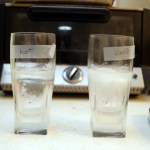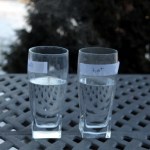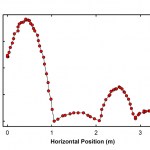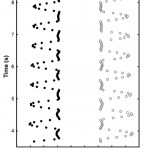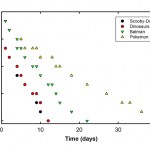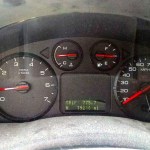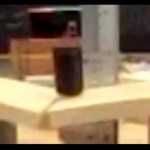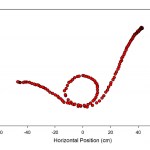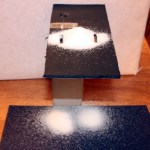Experiment
I mentioned in passing in the Forbes post about science funding that I'm thoroughly sick of hearing about how the World Wide Web was invented at CERN. I got into an argument about this a while back on Twitter, too, but had to go do something else and couldn't go into much detail. It's probably worth explaining at greater-than-Twitter length, though, and a little too inside-baseball for Forbes, so I'll write something about it here.
At its core, the "CERN invented WWW" argument is a "Basic research pays off in unexpected ways" argument, and in that sense, it's fine. The problem is, it's not…
This one's late because I acquired a second class for the Winter term on very short notice. I was scheduled to teach our sophomore-level "Modern Physics" class, plus the lab, but a colleague who was scheduled to teach relativity for non-majors had a medical issue, and I'm the only other one on staff who's ever taught it, so now I'm doing two courses instead of one. Whee!
Anyway, here are my December posts from Forbes:
-- Science Is Not THAT Special: Another in a long series of posts grumbling about the way we set science off from other pursuits and act as if the problems facing it are unique…
It's been a while since I last rounded up physics posts from Forbes, so there's a good bunch of stuff on this list:
-- How Do Physicists Know What Electrons Are Doing Inside Matter?: An explanation of Angle-Resolved Photo-Electron Spectroscopy (ARPES), one of the major experimental techniques in condensed matter. I'm trying to figure out a way to list "got 1,800 people to read a blog post about ARPES" as one of my professional accomplishments on my CV.
-- The Optics Of Superman's X-Ray Vision: Spinning off a post of Rhett's, a look at why humanoid eyes just aren't set up to work with x-rays…
One of my favorite modern tales of scientific discovery is the Mpemba Effect, named after Erasto Mpemba, a schoolboy in Tanzania who noticed while making ice cream that hot mix put in the freezer solidified faster than cold. This counter-intuitive result has been replicated a bunch of times, and physicists and chemists continue to debate the reason for it.
It was bitterly cold this weekend, dipping down into the negative Fahrenheit, which wasn't great for, you know, leaving the house, but did provide an opportunity to test the Mpemba Effect. Because when the icy winds of winter blow, that's a…
It was bitterly cold over the weekend here in the Northeast, with daytime high temepratures in the single digits Fahrenheit. This has little to recommend it in terms of, you know, leaving the house, but it did provide an opportunity to try some SCIENCE!
Unfortunately, I left the notepad with the data (such as it is) on it at home when I came to Starbucks to write, so I can't do the detailed write-up. I'll use it for the photo of the day, though, from which you can probably guess what I was trying to do:
Starting condition for a science experiment.
Detailed explanation of methods and…
One of the things about being a physicist that makes it tough to have any sensible work-life balance is that I'm constantly seeing little things and thinking "Oooh! Physics!" then getting distracted from what I'm actually supposed to be doing. Take, for example, our bathroom sink.
I have noticed, from time to time, a weird effect where the stream of water coming out of the faucet, which normally is fairly straight, will spread out when the water level in the container below gets close to the faucet. This turns out to be damnably difficult to replicate, though, and I've spent more time than I…
I followed up my ranty-y post about "Sports Science" with an experimental investigation over at Forbes, tossing a football around on the deck out back and then doing video analysis of the bounces. This provided a wealth of data, much of it not really appropriate for over there, but good for a physics post or two here.
One of the trajectories I looked at was this "forward bounce":
Here's the trajectory reconstructed in Tracker:
Trajectory of a football bouncing forward.
This is notable because not only does it bounce forward, it includes one of those big pop-up bounces that take people off…
A little while back, I used a photo of SteelyKid's toy Newton's cradle as the photo of the day, with a bonus video:
I mentioned that I was going to do some analysis of this at some point, but didn't have time right then. I had a bit of time to poke at this yesterday, though, so here's some physics making use of the normal-speed part of that video (I have another purpose in mind for the high-speed stuff; you'll need to wait for that).
The obvious thing to do with this is to plug it into Tracker and measure the position as a function of time. Here's a graph tracking the position of the two end…
I've been slacking in my obligation to use this blog for self-promotion, but every now and then I remember, so here are two recent things where I was interviewed by other people:
-- I spoke on the phone to a reporter from Popular Mechanics who was writing a story about "radionics" and "wishing boxes," a particular variety of pseudoscience sometimes justified with references to quantum mechanics. The resulting story is now up, and quotes me:
It is hard to investigate the ethereal thinking around radionics, but physics is something that can be parsed. So I got in touch with Chad Orzel, a…
A few years back, I did a couple of posts on the physics of a sad balloon (that is, a helium balloon that can no longer lift itself up to the ceiling), the first on simple buoyancy, the second on how long it takes for the helium to leak out. These were based on only a couple of data points, though, and it's always risky to extrapolate too far from just two points.
Of course, in a house with two kids, we have helium balloons show up with some regularity, and SteelyKid's birthday this year provided a bounty of them-- four shiny Mylar balloons, bearing cheerful images of Scooby-Doo, some cartoon…
There's a new Science Express paper on interfering clocks today, which is written up in Physics World, with comments from yours truly. The quote is from a much longer message I sent-- with no expectation that it would end up as anything other than a pull quote, I might add, but I thought the background would be helpful. Since I ended up doing a back-of-the-envelope estimate for that, though, I thought I would reproduce some of the reasoning here.
The basic proposal idea here is to do an atom interferometer inside a Ramsey interferometer for making an atomic clock. That is, before sending the…
I spent the last few days in Ontario, attending the Convergence meeting at the Perimeter Institute. This brought a bunch of Perimeter alumni and other big names together for a series of talks and discussions about the current state and future course of physics.
My role at this was basically to impersonate a journalist, and I had a MEDIA credential to prove it. I did a series of posts at Forbes about different aspects of the meeting:
-- The Laser Cavity was Flooded: a revisiting of the idea of True Lab Stories, which was a loose series of funny disaster tales from the early days of…
I've been really busy with year-end wrap-up stuff, but have also posted a bunch of stuff at Forbes. which I've fallen down on my obligation to promote here... So, somewhat belatedly, here's a collection of physics-y stuff that I've written recently:
-- Using Atoms To Measure Tiny Forces: A post reporting on some very cool atom interferometry experiments, one working to measure the very tiny (but known to exist) force of gravity, the other searching for a possible "fifth force" sort of thing.
-- Making And Shaking New Materials With Ultracold Atoms: A post reporting on a couple more DAMOP…
I was proctoring an exam yesterday in two different sections of the same class, so I had a lot of quite time. Which means I wrote not one but two new posts for Forbes...
The first continues a loose series of posts about the exotic physics behind everyday objects (something I'm toying with as a possible theme for a new book...), looking at the surprisingly complicated physics of an incandescent light bulb. A light bulb filament emits (to a reasonable approximation) black-body radiation, which is historically important as the starting point for quantum physics. But when you think about it, it's…
One of the highlights of teaching introductory mechanics is always the "karate board" lab, which I start off by punching through a wooden board. That gets the class's attention, and then we have them hang weights on boards and measure the deflection in response to a known force. This confirms that the board behaves like a spring, and you can analyze the breaking in terms of energy, estimating the energy stored in the board, and the speed a fist must have to punch through the board. As a sort of empirical test, we can drop a half-kilogram mass from the appropriate height to match the…
The big social media blow-up of the weekend was, at least on the science-y side of things, the whole "boys with toys" thing, stemming from this NPR interview, which prompted the #GirlsWithToys hashtag in response. I'm not sorry to have missed most of the original arguments while doing stuff with the kids, but the hashtag has some good stuff.
The really unfortunate thing about this is that the point the guy was trying to make in the interview was a good one: there's an essentially playful component to science, even at the professional level. I took a stab at making this same point over at…
One of the points I make repeatedly in teaching introductory mechanics (as I'm doing this term) is that absolutely every problem students encounter can, in principle, be solved using just Newton's Laws or, in the terminology used by Matter and Interactions, the Momentum Principle. You don't strictly need any of the other stuff we talk about, like energy or angular momentum.
Of course, just because you can solve any problem using the Momentum Principle doesn't mean that you want to solve those problems that way. As an example of a problem that's really annoying to solve with just the Momentum…
The editor at Forbes suggested I should write something about the re-start of the Large Hadron Collider, so I did. But being me, I couldn't just do an "LHC, yay!" post, but talk about it in a larger context, as one of three major approaches to filling the gaps in the Standard Model:
The big physics story over the weekend was the re-start of the Large Hadron Collider at CERN, the world’s largest and highest-energy particle accelerator. It was initially started in 2008, but some key circuits failed shortly after it was switched on. A relatively quick patch job allowed it to operate at half its…
SteelyKid is spending a couple of days this week at "Nerf Camp" at the school where she does taekwondo. This basically consists of a bunch of hyped-up kids in a big room doing martial activities-- taekwondo class, board breaking, and "Nerf war" where they build an obstacle course and then shoot each other with dart guns. Which, of course, required the purchase of upgraded Nerf weaponry, as seen in the "featured image" above.
This thing fires darts at a fearsome speed-- they hit the ceiling with really loud "thwack" that was a huge hit with both kids. Of course, you know what's coming next,…
Over at Scientific American's Frontiers for Young Minds blog, they have a great post on what happens when you ask scientists to explain key elements of a different research field. It's pretty funny, and rings very true, as SteelyKid asks me tons of science questions, very few of which have anything to do with atomic, molecular, or optical physics. so I spend a lot of time faking my way through really basic explanations of other fields.
Of course, even pitching stuff from my own field at the right level for small kids is a challenge. Which reminds me, I never did explain my presentation for…
